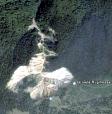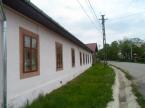Information
Făgăraş (Hungarian: Fogaras, German: Fogarasch) is a city of central Romania, in the Braşov County. It lies on the Olt River and has a population of 35,400 as of 2004.
Although the city has become almost totally Romanian-populated through Saxon and Hungarian emigration, the diverse background is still obvious. The most important attraction points in the city are the fortress, Radu Negru High school, the Reformed Church and the Roman Catholic Church.
Name
The name is alleged to derive from the Romanian word for "beech" (fag). Another, source of the name may be Hungarian, as the rendering of "wood" (fa) and "money" (garas), with legends stating that money made of wood had been used to pay the peasants who build the fortress around 1310.
History
Făgăraş was during the Middle Ages, together with Amlaş, a traditional Wallachian enclave in Transylvania, also called the Land of Vlachs (Romanians) in the 13th century. In those times, the settlement was centre of the surrounding royal estates belonging to the Hungarian kings.After the Tartar invasion in 1241-1242, Saxons settled in the area, too.In 1369, Louis I of Hungary gave the Royal Estates of Făgăraş to his vassal, Vladislav I of Wallachia, the territory remained in the possession of Wallachian Princes until 1464.During the rule of Transylvanian Prince Gabriel Bethlen (1613-1629), the city became an economic role model city in the southern regions of the realm. Bethlen rebuilt the fortress entirely.
Ever since that time, Făgăraş was the residence of the wives of Transylvanian Princes, as an equivalent of Veszprém, the Hungarian "city of queens". Of these, Zsuzsanna Lorántffy, the widow of George I Rákóczy established a Vlach (Romanian) school here in 1658. Probably the most prominent of the princesses residing in the town was the orphan Princess Kata Bethlen (1700-1759), buried in front of the Reformed church. The church holds several precious relics of her life. Her bridal gown, with the family coat of arms embroidered on it, and her bridal veil now covers the altar table. Both are made of yellow silk.
Făgăraş was the site of several Transylvanian Diets, mostly during the reign of Michael I Apafi.
The church was built around 1715-1740. Not far from it is the Radu Negru high school - built around 1909, it was originally a Hungarian language middle school where Babits Mihály taught for a while.
A local legend says that Negru Vodă left the central fortress to travel south past the Transylvanian Alps in become the founder the Principality of Wallachia, although Basarab I is traditionally known as the 14th century founder of the state. By the end of the 12th century the fortress itself was made of wood, but it was reinforced in the 14th century and became a stone fortification.
In the 20th century, Făgăraş's castle was used as a stronghold by the Communist regime of Romania. During the 1950s it was a prison for opponents and dissidents. After the fall of the Communist regime in 1989, the castle has been restored and is currently used as a museum and library.
The city's economy was badly shaken by the disappearance of most of its industries following the Revolution, critical hardships, and reforms. A large part of the city population left as guest workers to Italy, Spain, or Ireland.
See also
- Făgăraş Mountains

 English
English









